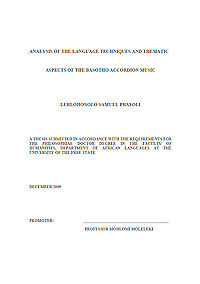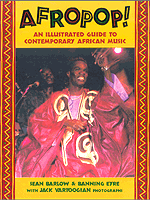phafoli2009
|
Phafoli, Lehlohonolo Samuel: |
 CONTENTS
CONTENTS
Abstract ii
Opsomming ii
Declaration iii
Acknowledgements iv
Abbreviations v
Key words vi
Table of contents vii
Chapter 1
Intrdoduction
1.0 introduction 1
1.1 Background 1
1.2 Statement of the problem 4
1.3 Purpose of the study 4
1.4 Value of the research 5
1.5 Definition of terms 6
1.6 Scope of the study 8
1.7 Literature review 9
1.7.1 History of Southern African township music and
Basotho accordion music 10
1.7.2 Basotho migrant labourer’s lifela/travellers’ songs 16
1.7.3 Basotho music 18
1.7.4 African music in general 18
1.8 Methodology 19
1.8.1 Research design 19
1.8.2 Population 19
1.8.3 Sample 19
1.8.4 Sample procedure and sampling technique 19
1.8.5 Data collection 21
1.8.6 Collection of cassettes 21
1.8.7 Interviews 22
1.8.8 Observation 23
1.9 Conclusion 24
Chapter 2
Theoretical framework
2.0 Introduction 25
2.1 Elements of functionalism 26
2.1.1 Function 26
2.1.2 Social system 27
2.1.3 Social Structure 27
2.2 Overview 28
2.2.1 Function 28
2.2.2 Interdependence 29
2.2.3 Consensus 31
2.2.4 Equilibrium31
2.2.5 Evolutionary change 32
2.3 Conclusion 33
Chapter 3
Historiography of Basotho accordion music
3.0 Introduction 34
3.1 The concept of Mosotho and Sesotho 34
3.1.1 Examples of dynamic changes within the Basotho culture 37
3.2 Overview of Basotho music in general 41
3.2.1 Traditional music 42
3.2.2 Acculturation in Lesotho 1980-2005 44
3.2.3 Transformation within church services 45
3.2.4 Gospel music 47
3.2.5 Jazz music 48
3.2.6 Choral music 49
3.3 Origins of the Basotho accordion music 49
3.3.1 Evolution of accordion music 1980-2005 53
a) The beginning 1980-1985 53
b) Military era 1986-1993 54
c) Mokhehle era 1993-1998 54
d) Mosisili era 1998-2005 55
3.3.2 The status of the music 56
a) Artists and their training 58
b) Performance 60
c) Naming of the albums 62
3.3.3 Language usage 64
3.3.4 Predominant themes of the accordion music 64
3.3.5 Musical Instruments 65
3.3.6 Recording 65
3.3.7 Accordion music and its reception 67
3.3.8 General views 68
a) Appreciation of the lyrics in the music 68
(i) Use of Sesotho as a mother tongue 68
(ii) Employment of language techniques 69
(iii) Manipulation of emotions 70
(iv) Thematic aspects 71
b) Appreciation of Personal identity 71
(i) Eloquence 72
(ii) Voice 73
(iii) Dramatic performance 74
(iv) Musical instruments 75
(v) Social identification 76
3.4 Conclusion 79
Chapter 4
Analysis of the language in accordion music
4.0 Introduction 80
4.1 Poetic nature of accordion music language 82
4.2 Proverbs 89
4.2.1 Application of proverbs 92
4.2.2 Use of proverbs 96
a) Proverbs used as titles of songs 97
b) Proverbs with no fixed or rigid pattern 100
4.3 Figures of speech 102
4.3.1 Apostrophe 103
4.3.2 Euphemism 108
4.3.3 Hyperbole 113
4.3.4 Imagery 120
4.3.5 Metaphor 127
a) Animal metaphors 128
(i) Animal metaphors with positive attitude 129
(ii) Animal metaphors with negative attitude 131
b) Plant metaphors 134
c) Bird metaphors 135
d) Natural phenomena 137
4.3.6 Repetition 140
a) Repetition of chorus 142
b) Repetition of letters or syllables 144
c) Repetition of clauses and phrases 146
d) Repetition of words 148
e) Repetition of one idea in different words 150
4.3.7 Simile 152
4.4 Conclusion 157
Chapter 5
Thematic aspects of Basotho accordion music
5.0 Introduction 159
5.1 The social context of accordion music artist 159
5.2 Analysis of thematic apsects 161
5. 3 Social aspects 161
5.3.0 Introduction 161
5.3.1 Concept of self 162
a) Birth 163
b) Identification by clan 166
c) Names places of origin 168
d) Names of chiefs 171
e) Nurture of the artist 174
f) Marriage life 176
g) Working experience in the Republic of South Africa 179
5.3.2 Social trends common to accordion artists 182
a) Advice 183
b) Extramarital affair 186
c) Dishonesty 189
d) Death 191
e) Portrayal of women 193
f) HIV/AIDS 198
g) Tribute to accordion artists 201
5.3.3 Tradition and Change 203
5.4 Economic aspects 207
5.4.0 Introduction 207
5.4.1 Background 207
5.4.2 Poverty in Lesotho 210
a) State of poverty 211
b) Poverty alleviation 212
c) Unemployment 214
5.4.3 Exploitation by coordinators and recording companies 214
a) Exploitation by coordinators 215
b) Exploitation by recording companies 217
5.4.4 Protest against chinese firms 220
5.5 Political history 224
5.5.0 Introduction 224
5.5.1. Background 224
5.5.2 Political Events of 1986 227
5.5.3 Political Events of 1987 230
5.5.4 Political Events of 1991 231
5.5.5 Political Events of 1993 234
5.5.6 Political Events of 1994 235
5.5.7 Political Events of 1997 237
5.5.8 Political Events of 1998 239
5.5.9 Political Events of 2000 242
5.6 Conclusion 244
Chapter 6
Conclusion
6.1 Findings and other possible areas of research 246
6.1.1 Findings 246
6.1.2 Possible areas of further research 250
6.2 Problems encountered 252
6.3 Conclusion 253
6.4 Recommendations 255
6.4.1 Recommendations for artists 255
6.4.2 Recommendations for artists 255
Bibliography
Books 257
Journals 262
Dissertations and thesis 262
Unpublished papers 263
Internet 263
Newspapers, radio & television 264
Artists’ songs and albums 266
Reports 269
Interviews 270
Artists (Interviews) 270
Coordinators (Interviews) 271
Radio and television presenters (Interviews) 271
Some members of the public (Interviews) 272
Speeches 272
Appendix
Interview questions per group 274
Artists 274
Radio presenters 275
Hawkers 275
Audience 276


 CONTENTS
CONTENTS CONTENTS
CONTENTS INHALT (Button Type)
INHALT (Button Type) CONTENTS
CONTENTS